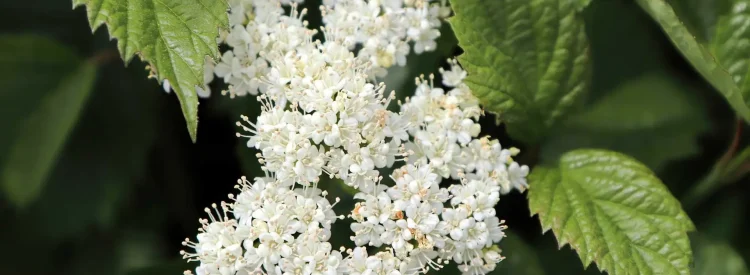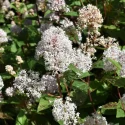Viburnums are a beloved group of plants for a reason: they change dramatically throughout the year, offering cinematic landscaping. (This is a big advantage over boring evergreen choices like boxwoods and yews.) Viburnums go from leaves > to flowers > to berries > to fiery fall foliage. They are a go-to for professional landscapers for their ease of care and beauty.
There are 150+ viburnum species worldwide with several native to North America (not including cultivars). Scroll on to meet some favorites.

Viburnums are beloved worldwide, but sadly the Asian species have taken the spotlight when it comes to landscaping. Let’s turn that around! Several native viburnums are just as gorgeous as non-native viburnums and offer lots more benefits for North American gardeners.
So, you may be wondering…
What’s the benefit of planting native viburnums?
Planting native instead of non-native viburnums offers so many benefits:
- Super low maintenance: Native viburnums need minimal care to thrive. This is difference from some non-native viburnums, which can requite fertilizers or special care.
- It’s a bird magnet. Native viburnums cover themselves in berries in the fall, which attract birds like the phoebe, mockingbird, robin, brown thrasher, northern flicker, cardinal, cedar waxwing, vireo, bluebird, and grosbeak (list from Brooklyn Botanic Garden).
- Comes back year after year: this is a perennial plant that comes back year after year, each year getting bigger and better. So plant once and enjoy for years!
And one more reason…
Native viburnums are host plants
Host plants are specific plants that a bug or butterfly lays its eggs on, and its caterpillars eat. (Here’s a short host plant overview.) They are powerful choices for our landscaping because they ensure iconic native species thrive.

Viburnum are host plants
Native viburnums are the host plants for many beautiful creatures, including the Spring Azure butterfly. Every native viburnum you plant helps ensure that mom Spring Azures have a place to lay their eggs, and their baby caterpillars have food to eat.
Meet some native North American viburnums
Now that we know some reasons why to plant native viburnums, let’s meet some options to consider:

American Cranberry Bush / Cranberry Viburnum
Viburnum trilobum
Stop everything you’re doing and plant this one immediately: it’s gorgeous AND the fruits are edible to humans! They can grow up to 12′ high, making them great for hedgerows and living fences.
Although it’s often called a “cranberry bush” these fruits are NOT cranberries—they are viburnum berries! They taste like tart cherries and are most often used for making jams and pies (sugar helps.)
Arrowwood Viburnum
Viburnum dentatum
Arrowwood’s name comes from its straight branches, which Native Americans used to make arrows. In the fall, its leaves turn into orange-red gradients alongside blue-colored berries. It gets 6-12′ tall.
Arrowwood Viburnums can be planted almost anywhere—in full sun, part shade, etc.—making them perfect for beginner gardeners. Read our Arrowwood Viburnum plant profile.

Blackhaw Viburnum + Southern Blackhaw Viburnum
Viburnum prunifolium + Viburnum rufidulum
Blackhaw and Southern Blackhaw Viburnums turn into small trees, topping out around 20′. Their leaves put on a dramatic show in the fall, turning deep shades of purple-red. The fruits are also edible, although many garden books and blogs advise it may be hard to get to the berries before the birds do.

Maple Leaf Viburnum
Viburnum acerifolium
This is a smaller shrub (topping out around 6′) that loves wet areas. It’s leaves remind you instantly of maple trees (hence the name) and it also turns dramatic shades of red/orange in the fall. It’s a great choice to pair with lots of native perennial flowers.
A Southern Master Gardener shares an overview of native viburnums in this video:
FAQs
What does the name Viburnum mean?
Viburnum means ‘wayfaring tree’ in Latin. In the British Isles and parts of Europe, seeing viburnums helped indicate you were on or close to a path.
According to the Heart of England Forest, the name ‘wayfaring tree’ was coined by 16-century herbalist John Gerard, “who noticed them [viburnums] along paths between Wiltshire and London in the late 1500s. They became associated with being on or near a path, preventing travelers from getting lost.”
How much sunlight do native viburnums need?
Most native viburnums, such as Arrowwood Viburnum (Viburnum dentatum) and American Cranberry Bush (Viburnum trilobum), are highly adaptable. They thrive in full sun to partial shade, though more sunlight typically results in better flowering and fruiting. They are perfect for a range of garden conditions.
Can I see a list of all the North American native viburnums?
Here you go! Each link takes you to their corresponding USDA Plants database profile.
- American Cranberrybush Viburnum (Viburnum opulus var. americanum)
- Blackhaw Viburnum (Viburnum prunifolium)
- Downy Arrowwood (Viburnum rafinesqueanum)
- Hobblebush (Viburnum lantanoides)
- Mapleleaf Viburnum (Viburnum acerifolium)
- Nannyberry Viburnum (Viburnum lentago)
- Possumhaw Viburnum (Viburnum nudum)
- Rusty Blackhaw Viburnum (Viburnum rufidulum)
- Smooth Arrowwood (Viburnum recognitum)
- Southern Arrowwood (Viburnum dentatum)
- Squashberry (Viburnum edule – range mostly in Canada and upper US)
- Walter’s Viburnum (Viburnum obovatum)
- Witherod Viburnum (Viburnum nudum var. cassinoides)
What are good pairings for native viburnums?
Whenever planting a garden, you want to ensure there is always something to look at, no matter the season. The following native plants offer lots of seasonal beauty alongside native resilience:
Native plants for the spring
Native plants for the summer
Native plants for the fall
In conclusion, somehow non-native viburnums have gotten the landscaping spotlight over the years—it’s time to turn that around! Native viburnums deliver beauty, fuss-free gardening, AND magical host plant powers. They are a no-brainer when it comes to landscaping for yards or parks. Enjoy the beauty, butterflies, and birds whenever you plant native viburnums. Happy planting!
Sources
- Brooklyn Botanic Garden, Native Viburnums. (2002).
- Nelson, Gil. Best Native Plants for Southern Gardens: A Handbook for Gardeners, Homeowners, and Professionals, (2010).
- Harstad, Carolyn. Go Native! Gardening with Native Plants and Wildflowers in the Lower Midwest. (1999), 209-210.
- Heart of England Forest, Wayfaring Tree. https://heartofenglandforest.org/wayfaring-tree.
- The Editors of Encyclopaedia Britannica. “John Gerard | Herbalist, Botanist, Gardener.” Encyclopedia Britannica, July 20, 1998. https://www.britannica.com/biography/John-Gerard.
What if your feed was actually good for your mental health?
Give your algorithm a breath of fresh air and follow us.




































